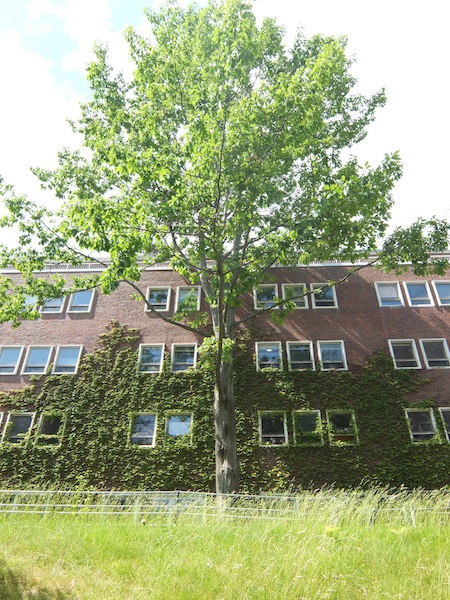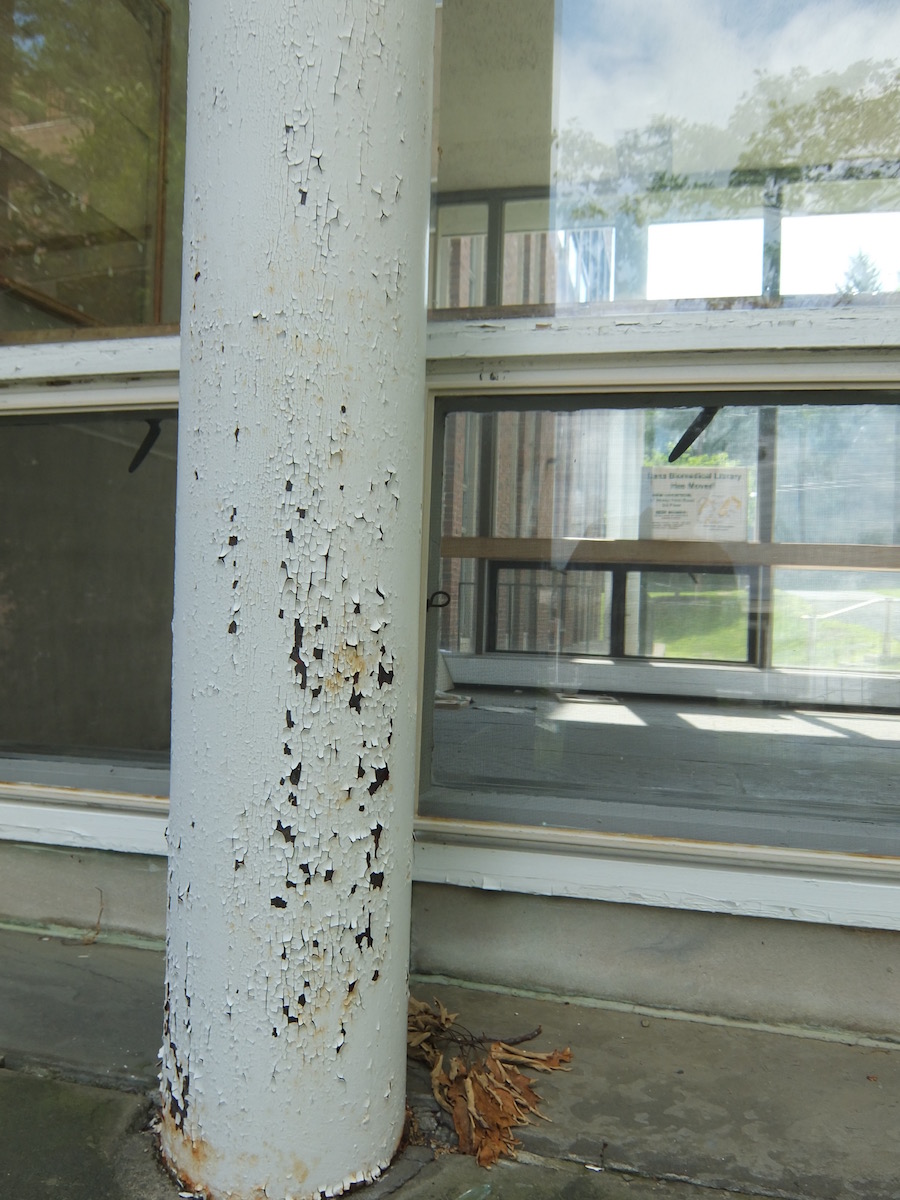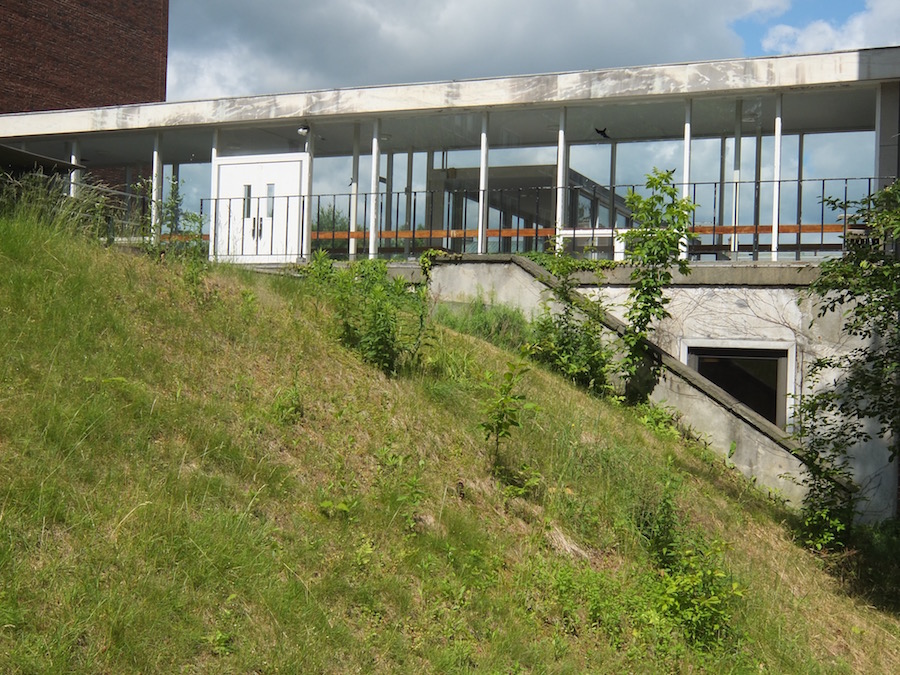-
Sasaki Associates now has a page for its House Centers “pilot” program. This SCUP article has a “housing swarm” image that Sasaki created for Dartmouth. A Valley News article states that the college “estimated it will cost $12.8 million to build professors’ residences and temporary centers for Dartmouth’s Undergraduate House Communities program.” But those have already been built. Presumably that estimate refers to completed construction. Any future, permanent versions of those buildings will cost a lot more than $13 million.
-
BBB has updated its page on the campus master plan to include a large version of that plan, an image of the West End plan (Green to Blue), and — this is new — a schematic perspective rendering of the cemetery bridge, which we can call Fletcher Viaduct.
-
This Valley News article notes Kendal’s interest in building to the south on Rivercrest land and leaving the Chieftain land for recreation (rowing).
-
Sir John Soane’s Museum in London has a computer model of the museum on line.
-
The architects have completed a design for the Irving Institute (Valley News).
-
The Dartmouth has an article on the success of the Town fence in front of Collis in reducing jaywalking.
-
The Hood has a brochure on public art on campus. The Class of 1965 has proposed to erect a statue of DOC founder Fred Harris in front of Robinson Hall. The campus architecture committee is considering the idea, according to the ’65 newsletter.
-
A bit of biography on David Hooke, who’s at the center of the new Moosilauke Ravine Lodge.
-
Dartmouth will play Brown at football in Fenway Park on November 10, Big Green Alert reports. Wild.
-
The Rauner Library Blog has a post about the Charter.
-
Kresge Library in Fairchild has turned 40 years old.
-
This Times editorial contains footnotes. Kinda neat, but also showy: if footnotes are needed here, why not everywhere? Or if the paper is to be relied on generally, why include notes here?
-
Big Green Alert points out the new use of the Lone Pine logo by the Co-Op. First impression? The trad typeface clashes with the fat Modernism of the pine. The use of the athletics nickname BIG GREEN in this seal-like, college-wide institutional device is also weird.
-
A Proliferation of Canes. Photos of the most recent Commencement show students carrying many strange, new-ish canes, most presumably representing senior societies. They feature a snake wrapped around a Native American arrow; a bearded old man; the domed main body of Shattuck Observatory (clever!); a snake clutching an apple in its mouth; a huge phoenix (for Phoenix, obviously — is that cast resin or something?); a tail, perhaps belonging to a whale?; and a three-dimensional stylization of the stylized Lone Pine symbol (also a metal globe).
-
Two interesting new-ish concepts: literary geography and forensic architecture.
Category Archives: preservation
Image of new Ledyard; selecting Ravine Lodge timbers
-
The Moosilauke project is beginning. Wow. See the aerial of timber framing. And see the unique, oddly-shaped timbers destined to become crucks and idiosyncratic railings and so on. Much of timber, the update states, was harvested under the direction of the College Forester from college lands on Trescott Road, off Grasse Road in Hanover.
-
The project page for the Ledyard Canoe Club replacement has a depiction of the future building. Taking advantage of the slope like a Pennsylvania bank barn, the clubhouse will stand three stories high.
-
The Rauner Library blog has a post on Dartmouth Night telegrams and a post on the Old Pine, particularly the fragment of the pine kept in the archives.
-
A presentation (pdf) from the summer shows possible bike lanes connecting Hanover and DHMC.
-
Speaking of Schinkel (in a post of two months ago), Adobe has produced a time-lapse video of Mike Campau recreating Schinkel’s lost painting Cathedral Towering Over a Town using thousands of bits of stock photos.
-
The 2015 Jones Media Center interior renovation in Berry Library was designed by Jones Architecture and built by North Branch. Jones also designed the DartmouthX Studio around the same time. It occupies the far east end of Berry.
-
What if the college, finding itself expanding onto the south end of the golf course, simply added another nine holes to the east (by the Rugby Clubhouse) and to the north (behind the Fire Department, even into the Fletcher Circle neighborhood)? The Times had an article on swapping the front and back nine on a golf course.
-
Microsoft’s Bing has its Streetside view (like Google Street View), and the service has come to Hanover. Are its photos taken at shorter increments than Google’s? It does seem easier to navigate, but it offers less coverage nationally and in Hanover. The photos seem less sharp. The aerial and bird’s eye views are superior to Google’s.
-
Some of the best photos yet of the DEN space in 4 Currier (project page) are in the Truex Cullins blog.
-
If the Dartmouth Cup (see the post from the summer) does not fill the role of a mace, the college’s eagle feather staff, featured in Dartmouth Now, surely could.
-
Dean of Libraries Jeffrey Horrell retired in June.
-
The Valley News reports that the owners of the Salt Hill Pub have bought the Seven Barrel Brewery in West Leb and that the college has sold its interest in Centerra Marketplace, the suburban mall partway to the hospital that houses a Co-Op Food Store location.
Co-Op Food Store in Centerra
———
11.28.2016 update: DEN project page link added.
Ledyard Canoe Club demo ahead
-
A campus construction update has a few details on the soccer pavilion expansion out at Burnham Field.
-
The Valley News reports that the new Dartmouth Coach bus station is opening in Lebanon.
-
An architect has been named for the Ledyard Canoe Club replacement. The historic clubhouse will be demolished and a new building built in its place by Charney Architects of New Haven.
-
A newsletter last month described the installation of a solar array at ground level on Berry Row.
-
The Moosilauke Ravine Lodge replacement (project page) is going ahead, and one can’t help but worry about the success of its central feature, the great stone fireplace-staircase (HearthStair?). Will it be plausible as a work of masonry, a little bit of Machu Picchu in the White Mountains? Or will it read as Formstone, with no visible means of support?
-
An item on memorializing the Lodge mentions some interesting digital projects and quotes OPO Director Dan Nelson: “Memorabilia will be saved, safely stored, and reinstalled; interior log elements will be reused; timbers that can’t be reused in construction will be sawn into planks for wall paneling.”
-
“Work is underway … planning for future renovation of the Hopkins Center” (news release; see also the story in The D).
-
“Also in the future is consideration of the north end of campus, focusing on the demolition of Gilman Hall — and creation of green space in its place” (The D). Let’s hope that this is a way of saying the Gilman site will not become a parking lot.
-
“— coupled with the complete renovation of Dana Hall for faculty use” (The D). Interesting — wasn’t the library moved out because Dana was to be demolished? Is that move now looking like a mistake, or would the renovation have required the building to be emptied anyway? Whatever the case, it’s good to hear that Dana is being renovated. It seems like an underappreciated building that might have some merit to it, some endearing features. The small size and the scale of the building are appealing.
-
The Rauner Blog has a post on the Surveyor General of the His Majesty’s Woods during the 1740s. It is worth noting that John Wentworth later became Surveyor General, and Eleazar Wheelock was accused of illegally harvesting pines marked with the King’s broad arrow.
-
Dartmouth is building a timber-framed pavilion at the Organic Farm to shelter a wood-fired pizza oven (Planning Board minutes 6 September 2016 pdf).
-
Dartmouth Engineer Magazine has a long article on the Williamson Translational Research Building by The Map Thief author Michael Blanding.
-
The D has an article about the end of football game broadcasts on campus radio; this year the football team switched to 94.5 ESPN. Dartmouth licensed athletic multimedia rights to Learfield Sports late last year. Learfield created Big Green Sports Properties to handle “all corporate sponsorship endeavors for the Big Green, including venue signage, promotions, radio advertising and ads on DartmouthSports.com” (new general manager announcement).
-
Mad River Glen ski area in Vermont is the only ski area on the National Register (history, NR nomination form pdf).
Now is the time for heraldry
ORL has opened a “House Insignia Design” search.
Although the webpage acknowledges that the Houses “do not have to be represented as shields or coats of arms,” the relevant tradition is that of heraldry, and the four house systems that are provided as examples (those of Rice, Harvard, Yale, and SMU) are dominated by shields.
Here are some rough sketches, with speculative blazons. The arbitrary House names assigned by ORL are probably only temporary and are not referenced in the arms. Comments and suggestions are welcome; feel free to submit any of these to ORL without attribution:
|
Allen House. |
 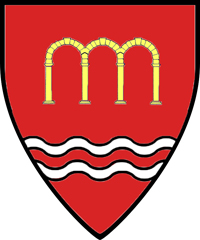  |
|
|
Constituent buildings: Gile, Streeter, and Lord Halls. Associations: Tuck Mall, the Gold Coast, the Hitchcock Estate, the Cemetery, architect Jens Larson’s ocular windows and connecting arcades. Possible blazon: Gules three arches conjoined Or in base two barrulets Argent. |
||
|
East Wheelock House. |
 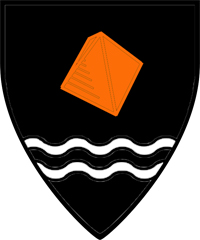  |
|
|
Constituent buildings: Andres, Zimmerman, Morton, and McCulloch Halls. Associations: Dr. Frost’s House, Judge Parker, the “New Dorms,” the ur-community, the postmodern entry pyramid. Possible blazon: Sable a pyramid proper in base two barrulets Argent. |
||
|
North Park House. |
 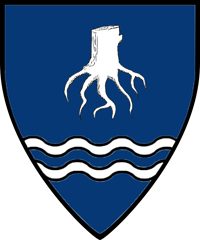  |
|
|
Constituent buildings: Ripley, Woodward, and Smith Halls. Associations: College Park, the Bema, the Old Pine or Lone Pine, the stump, the Grotto, early graduates and original college tutors Ripley, Woodward, and Smith. Possible blazon: Azure a tree stump erased in base two barrulets all Argent. |
||
|
School House. |
 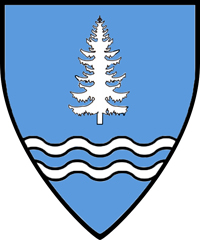  |
|
|
Constituent buildings: Massachusetts Row and Hitchcock Hall. Associations: Mass Row (“Mass Rowhouse”), a temple front, Boston, the Commonwealth of Massachusetts, the Massachusetts flag (whose reverse apparently displayed a green pine tree on a blue field from 1908 to 1971). Possible blazon: Azure a pine tree in base two barrulets all Argent. |
||
|
South House. |
 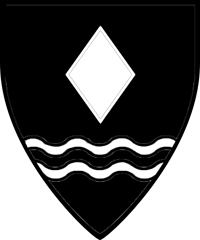  |
|
|
Constituent buildings: Topliff and New Hampshire Halls and the Lodge. Associations: Hallgarten (“Hellgate”), the New Hampshire College of Agriculture & the Mechanic Arts, the State College, present-day UNH (whose colors are blue and white), Aggies, father of NHC in Hanover Ezekiel Dimond, the State Farm (part of which is now occupied by the football field and baseball diamond), the plow. Possible blazon: Sable a lozenge in base two barrulets all Argent. |
||
|
West House. |
 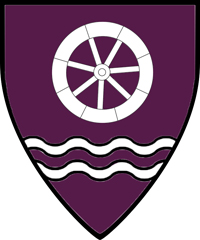  |
|
|
Constituent buildings: Butterfield, Russell Sage, Fahey, and McLane Halls. Associations: The mansion and estate of wealthy hotelier, philanthropist, and amateur archeologist Hiram Hitchcock, the landscaped auto road of Tuck Drive, a.k.a. Webster’s Vale, Eleazar Wheelock’s first college site (behind Sage). Possible blazon: Purpure a wheel in base two barrulets all Argent. |
New faculty houses, etc.
-
Fascinating and unexpected historic New Hampshire mica mine for sale: Eagle Tribune.
-
Bora (formerly Boora) Architects have put up a couple new images and larger versions of their old ones for the Hopkins Center expansion. The new porte-cochere, which would tear down Harrison’s stone wall and put up a transparent box with a glass “curtain” wall, is striking for the literalism of its opening-up of the Hop. The new reference to the project as “unbuilt” is troubling.
-
The Valley News reports on a Cambodian food truck that serves Hanover.
-
Big Green Alert reports on the plaque honoring Kathy Slattery Phillips in the new press box at Memorial Field.
-
Dartmouth Now reports that the board of trustees, at its Commencement meeting,
affirmed plans to proceed with the renovation and expansion of the Hood Museum of Art. The trustees also voted to approve $10 million for construction of the Moosilauke Ravine Lodge and $22 million to build a new indoor athletics practice facility. Each of these projects will be funded through private gifts to Dartmouth.
-
One of the goals of the current Thayer School fundraising campaign (Dartmouth Now):
Construct a 180,000-square-foot building, which will nearly double the school’s total floor space. The building, to be located directly south of the MacLean Engineering Sciences Center, will provide more space for classroom teaching and experiential learning, with an emphasis on Thayer’s growing efforts in design and research priorities in energy technology and engineering-in-medicine.
-
The Town of Orford celebrated the 250th anniversary of its founding with a reading of its charter on the East Common (Here in Hanover).
-
The Rauner Library Blog reports on a time capsule from 1977 that contained a can of Miller High Life. The can was kept in the archives but had to be drained recently.
-
Thanks to the U.Va. School of Architecture for including the Campus Guide in its 2016 Alumni Exhibit, on university living-learning environments.
-
The Valley News has a story on the Hartford Christian Camp. It sounds like a lovely place, and the kind of summertime experience that was common a century ago. In Charlottesville, Virginia, a similar camp has been incorporated into the city and its surviving cottages have become year-round houses:
-
U.Va. has a collection of campus then/now photos.
-
The Dartmouth has an article on the school’s architecture studio.
-
Big Green Alert reports on the new FieldTurf at Memorial Field.
-
Volunteers in Meriden are digitizing the E.H. Baynes slide archive, the Valley News reports. Baynes was the conservationist and traveling lecturer who, at a talk in Webster Hall during the early 1900s, suggested that Dartmouth students raise money to save the bison and adopt the animal as their mascot.
-
Green Building Advisor has a detailed look at the construction of the four new modular houses being installed for faculty as part of the “house communities” plan. The school has a video update on the construction. Big Green Alert has earlier and later photos of the tensile “community” building that now stands by Davis Varsity House.
-
It is common these days for sportswear companies to design team uniforms, logos, and mascots. For the British team at the 2016 Olympics, Adidas worked with both the College of Arms (England) and the Lord Lyon King of Arms (Scotland) to create a coat of arms that would be conferred by a dual grant (College of Arms news).
The Hood project is under way
Work on the demolition of a part of the Hood and the construction of a new wing has begun (Dartmouth Now).
The elaborate plan to move the Joel Shapiro sculpture (pdf) has been carried out, and the sculpture stands in the Maffei Arts Plaza by the VAC (Dartmouth Flickr). There is an informational exhibit about the project in the old museum shop (Expansion Updates). The project page has an updated view showing the building’s name on the north facade. The Hood Museum is opening a temporary gallery in the former Amidon Jewelers location downtown (Dartmouth Now).
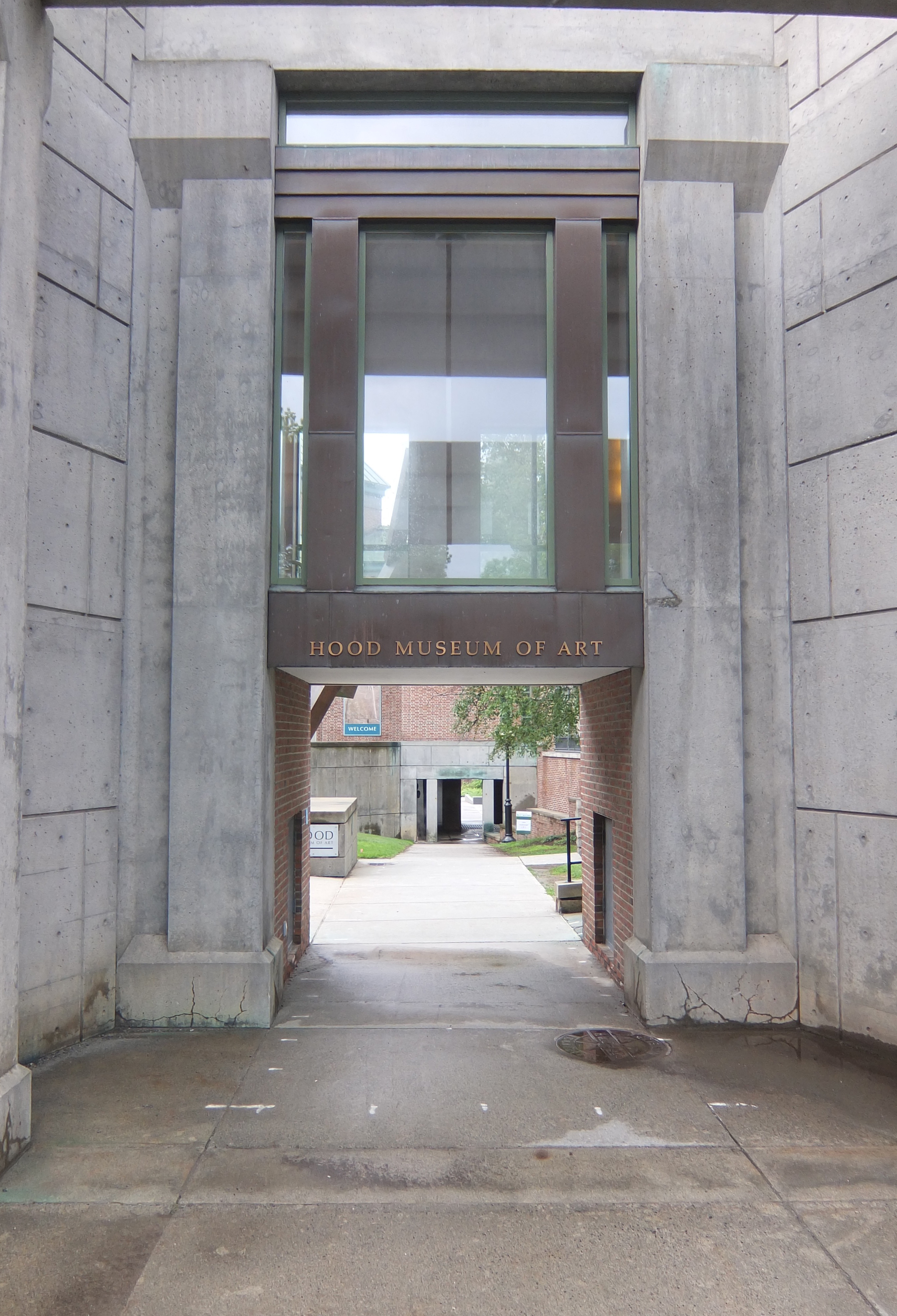
It is not something the architects usually do, but one wonders whether the gate could have been preserved within the new museum as a ruin or a fragment.
The Times quotes President Hanlon as saying “We are certain that Tod Williams and Billie Tsien have come up with a design that respects and preserves the core building and allows us to both repair the problems that exist and expand the museum for future generations of Dartmouth students.”
One of those problems, of course, is the obscurity of the entrance. The big gateway advertises the museum well enough, but once you go through it, you are on your own.
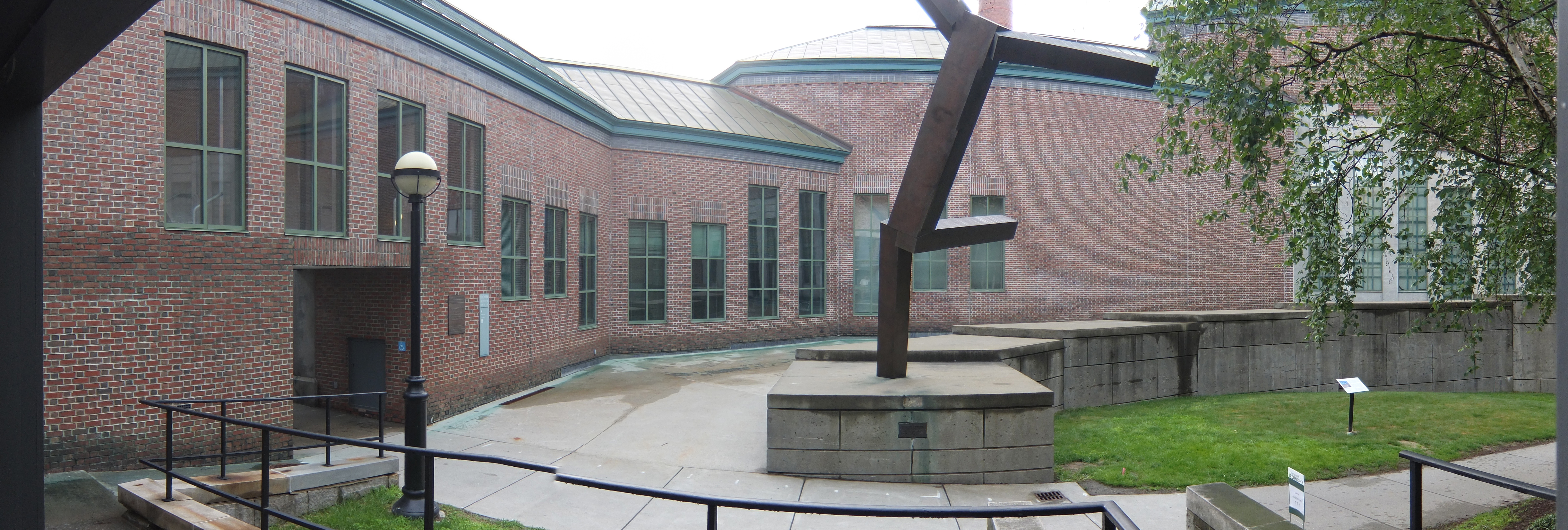
Curbed.com has an article with some alternative site plans proposed by Kevin Keim of the Charles Moore Foundation. Although the southern expansion would infringe on the dignity of the VAC, it really is implied by the way Moore had the museum trail off in that direction. See also the Metropolis article.
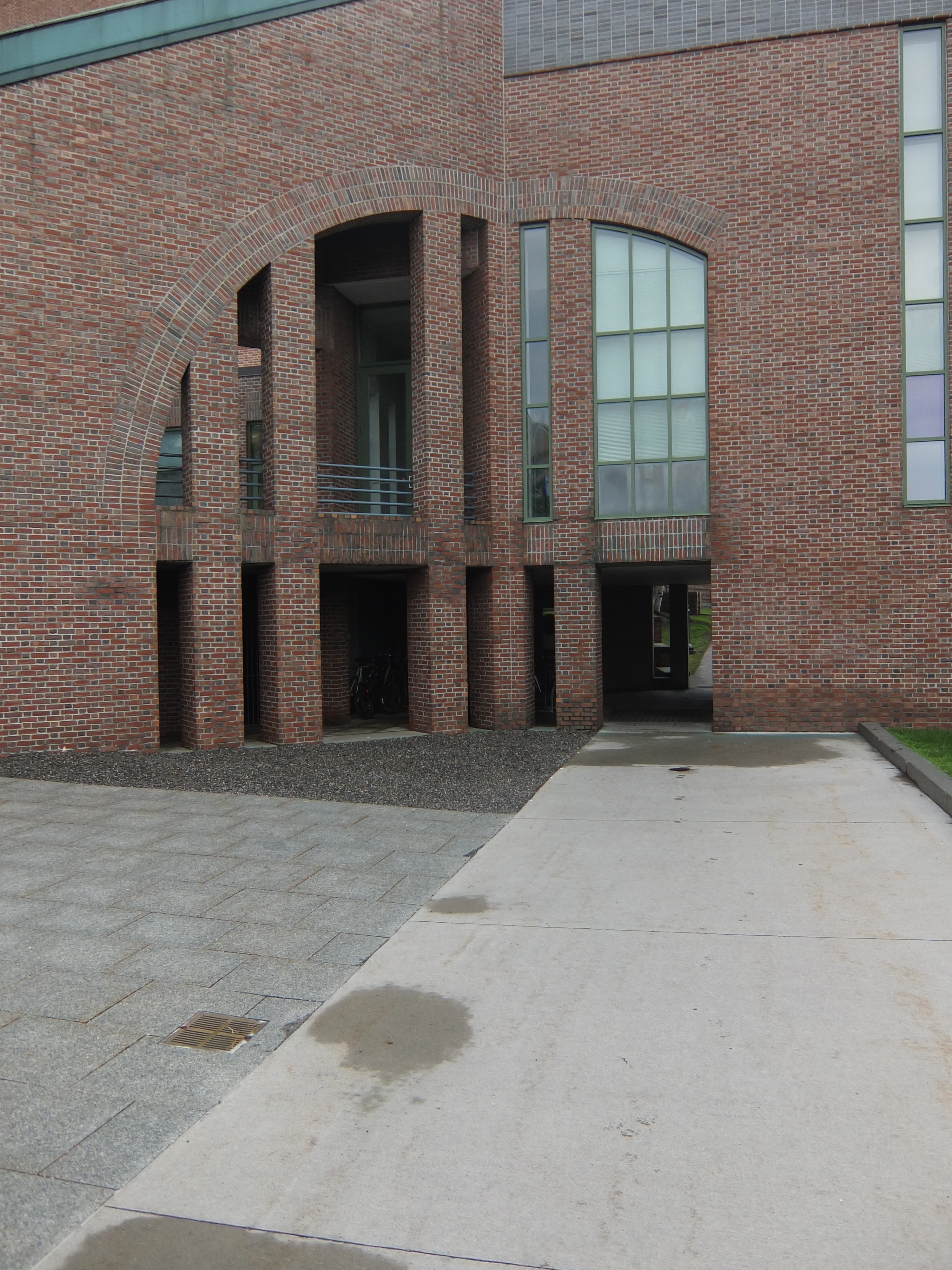
The word is that this facade is to be left undisturbed. In this context, that means “relatively undisturbed.” There will be some slicing and dicing at the righthand corner of that arched opening, as shown in this image.
Seven Days Vermont has an interview with new Hood Director John Stomberg. The Dallas Morning News reports that TWBTA has been hired to design the Obama Presidential Library in Chicago.

——
[Update 08.17.2016: Coding error corrected, wording of first paragraph clarified.]
More on the viaduct
This extension of Hanover’s historic street grid will carry Cemetery Lane across the Dartmouth Cemetery.
Generally
It is hard to resist calling it a bridge “to Thayer School.” If a Thayer parking deck ever goes in, visitors to campus will park there, and so this really will be a bridge “to the college.” The Thayer end of the viaduct will be the gateway to the college:
One could even imagine a brick tower, or a towering gate, at that spot, serving as both an entranceway and a landmark:
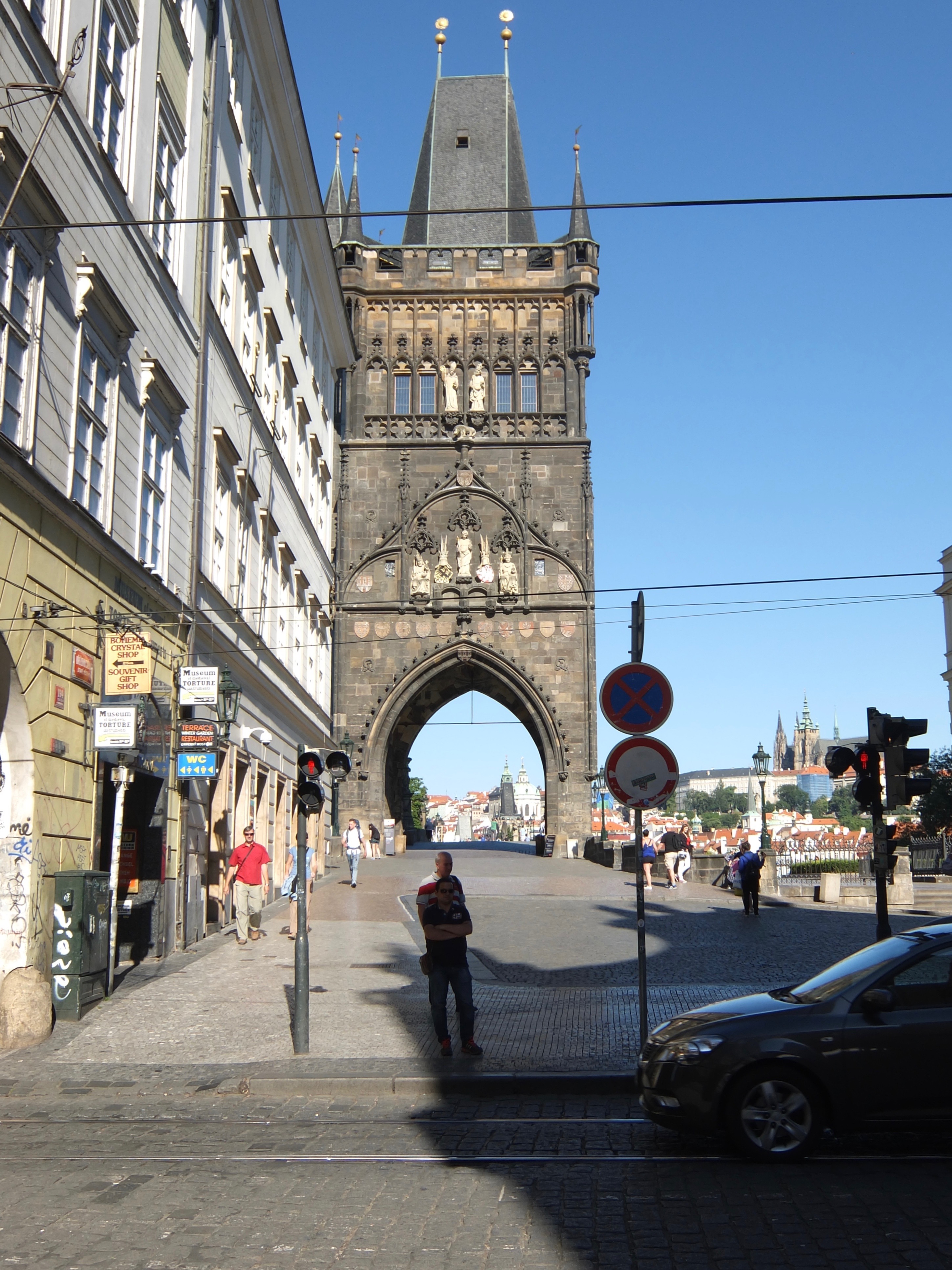
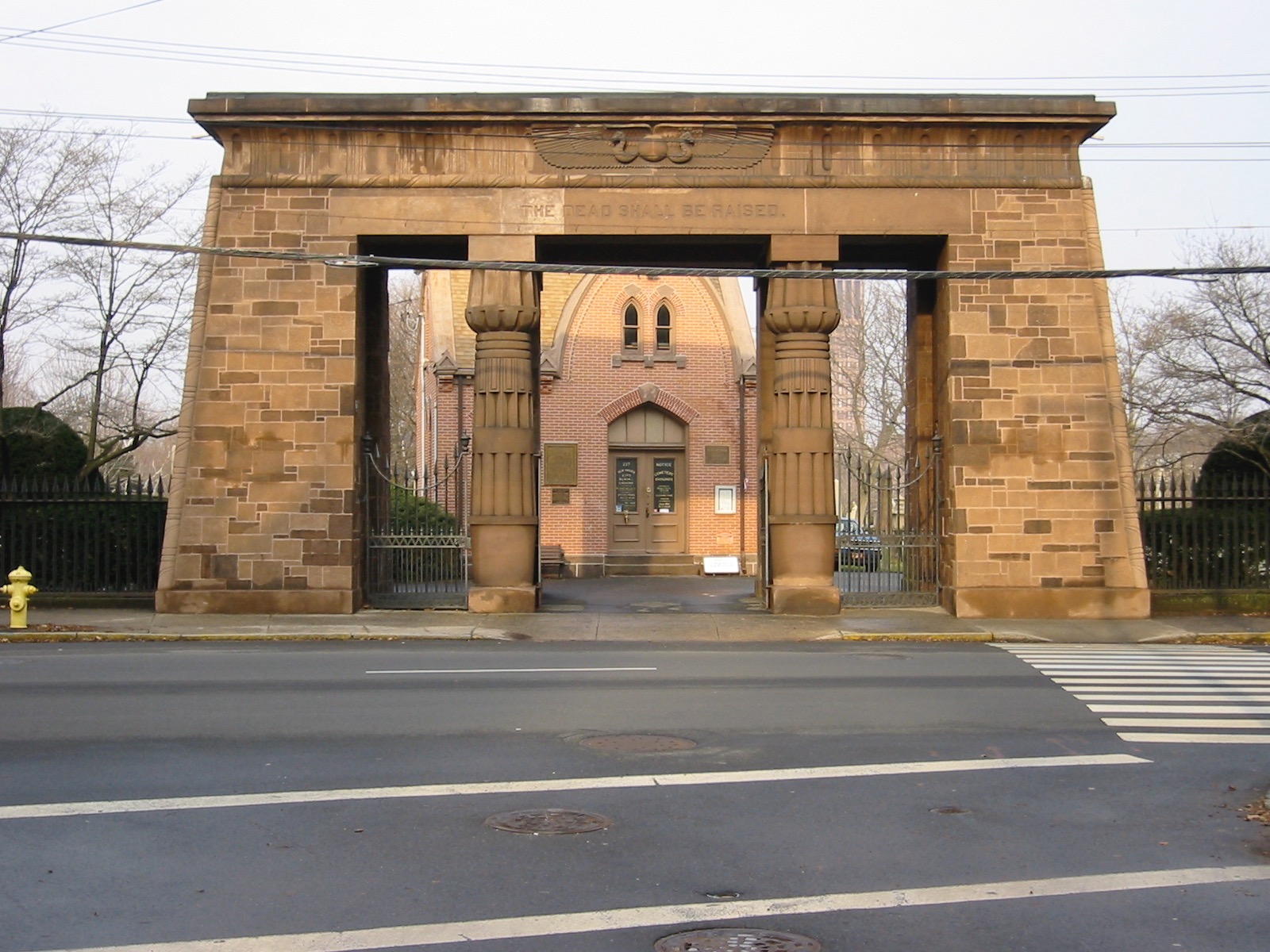
The Egyptian mode would be especially appropriate here, since the viaduct crosses a cemetery and Dartmouth has a sort of Egyptian thing going on (Sphinx, the Brace Commons pyramid, Amarna). The college motto would be a good thing to put above the gateway, because the visitor will be entering a wilderness of sorts, up in the trees.
Then this will be the new welcome for visitors after they come through the cemetery:
Not bad, but obviously a back entrance at the moment.
The footings
The footings will probably be minimalist, even spidery, to avoid landing in graves. (Incidentally, do they have a plan for what to do when they find unmarked graves?)
If the footings are bulked up and built of masonry, they could really announce themselves and interact with existing monuments (see this article on graves under the bridge at Montmartre in Paris for an idea). The bridge piers could even be rendered as obelisks and given plaques or inscriptions — as cenotaphs — although that would become hokey very quickly.
The structure
The deck should be wide enough for bicyclists and pedestrians to pass. There might be a need for rules about bikes.
The designers could do a nice elegant truss, not just a set of steel girders like Bartlett Hall’s rear stair (Street View).
Could the school get a set of beautiful green trusses from a historic rail or highway bridge that is being replaced somewhere in the Northeast? The trusses could be placed end-to-end and the decks hung off the sides; this could be a little museum of engineering.
Or the viaduct could refer to the ski jump, built by the Boston Bridge Company: see this simple profile drawing, in a Rauner Blog post on the ski jump.
This does not seem like the place to use a state-park style boardwalk bridge. The site seems to demand something permanent and monumental in form if not in scale. It would be better to err on the side of the depressing than the cheerful.
————-
[Update 08.06.2016: It turns out that Robert Fletcher, who singlehandedly brought Gen. Thayer’s idea for a school into being (Lee Michaelides, “In the Beginning,” Dartmouth Engineer Magazine), is buried in the Cemetery.]
Some campus photos and notes

The first stage of the steam tunnel’s construction, south of this grate, was a test meant to determine whether such a project would be economical in a ledge environment.
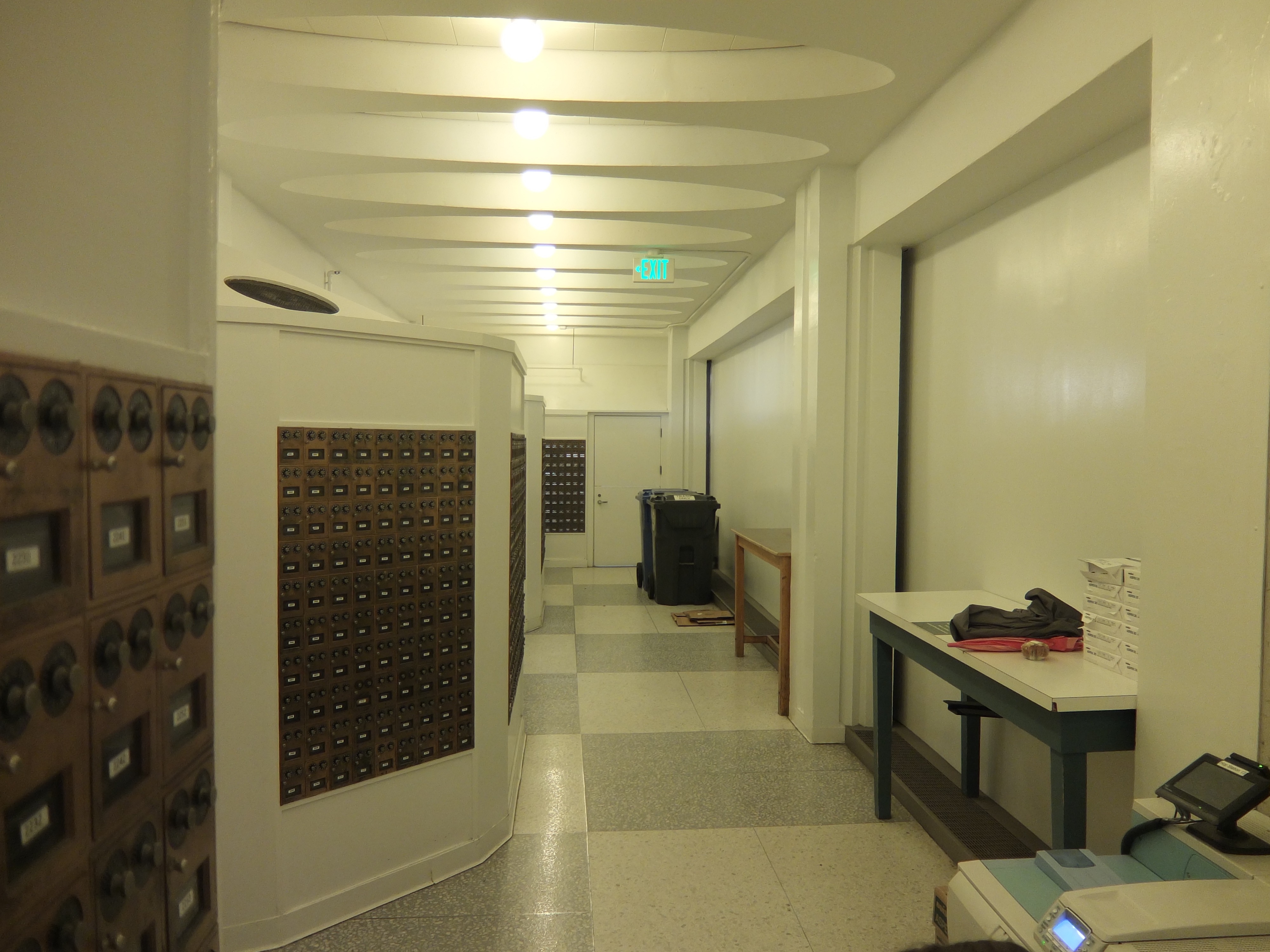
Until recently, students entered the Hop at the end of the room. The entrance was closed off and a replacement of the same configuration built just to the north.
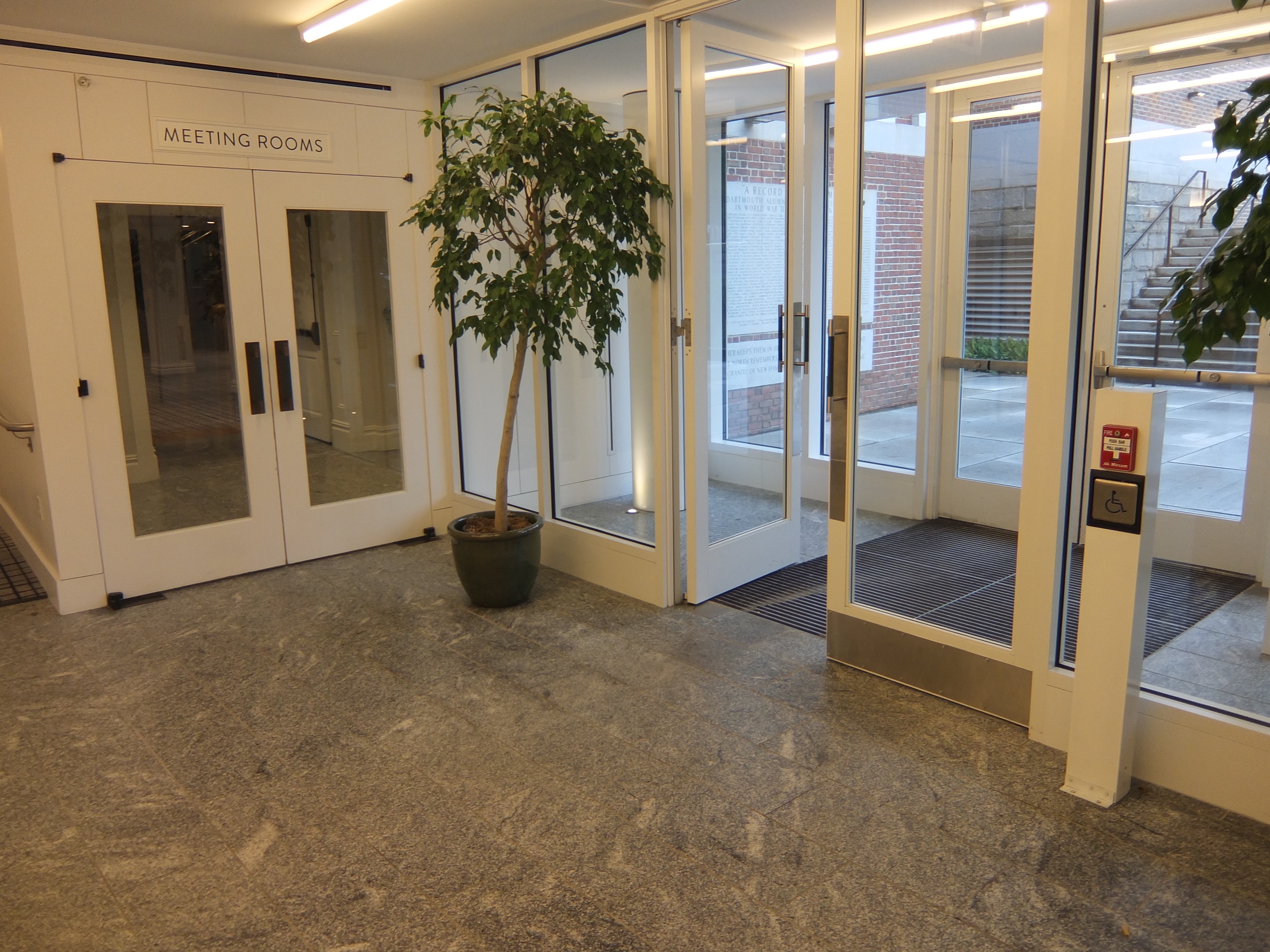
(Have the memorial plaques attached to the Inn there been moved to Memorial Field? That would make sense. This is not their first location anyway.)
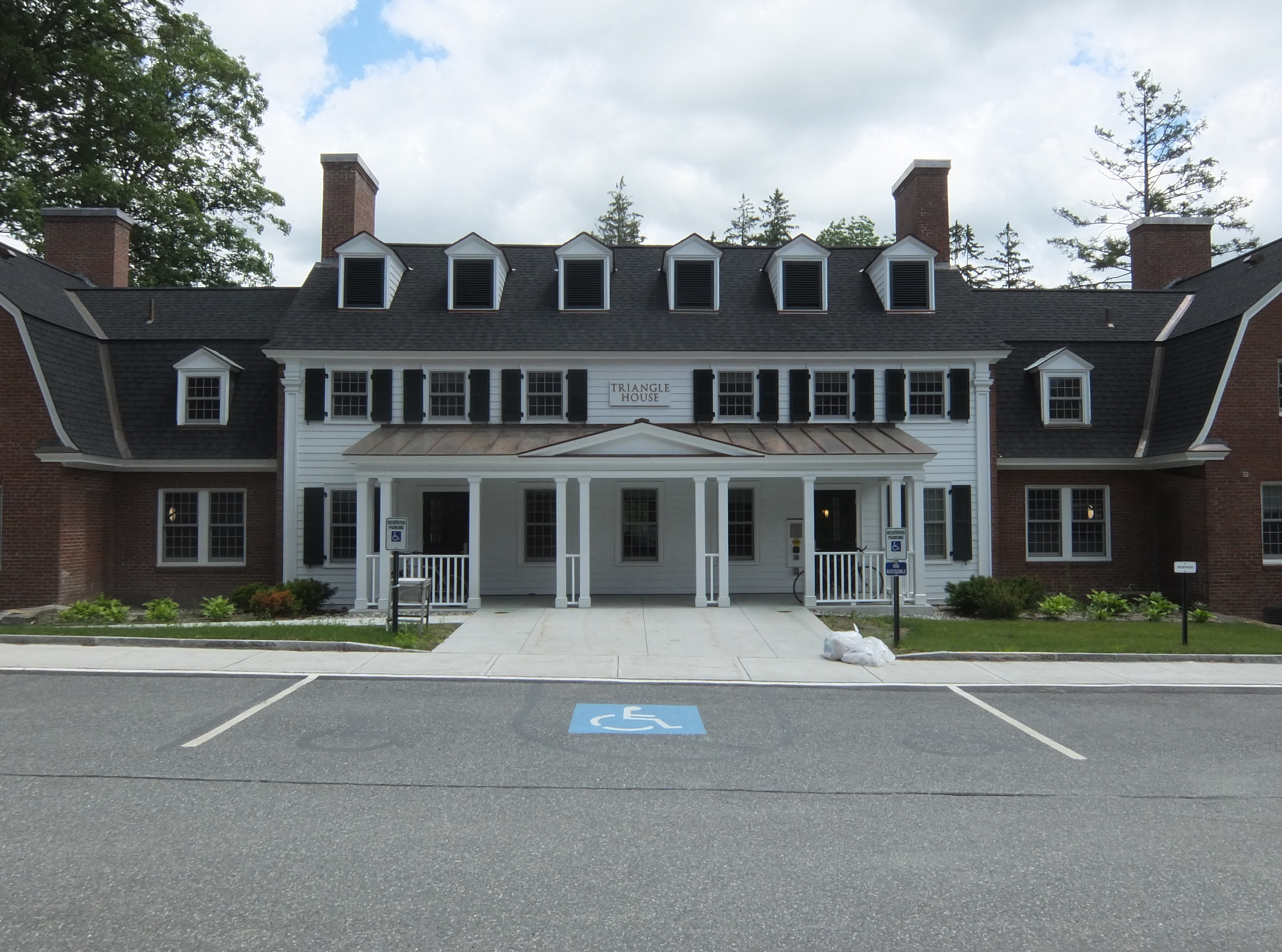
Even more than the society houses on the south side of Webster Avenue, Triangle House has a well-used student entrance on one side, shown here, and a formal street entrance on the other.
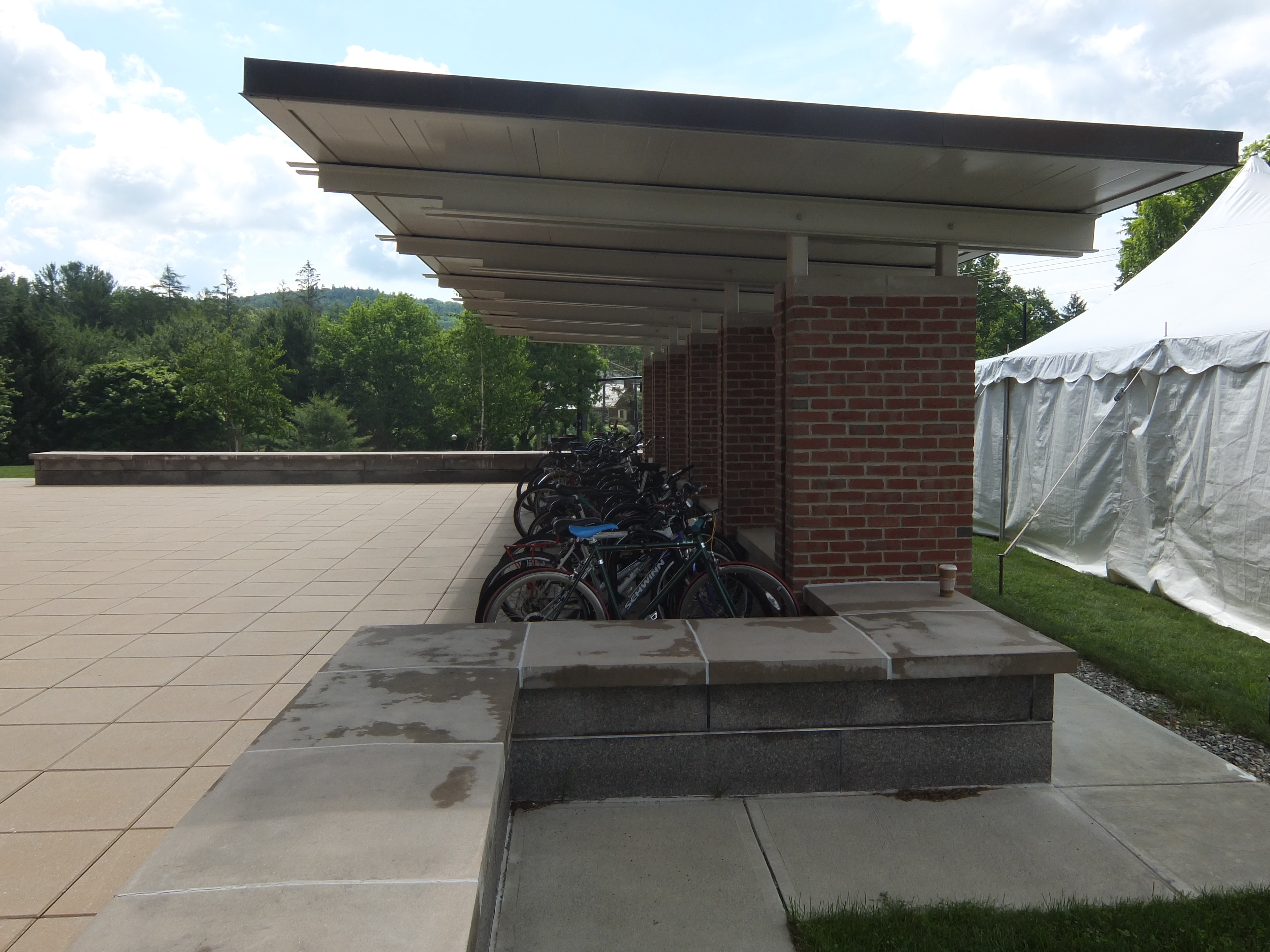
This elaborate bicycle shelter for the Life Sciences Center joins a couple other pavilions in the area.
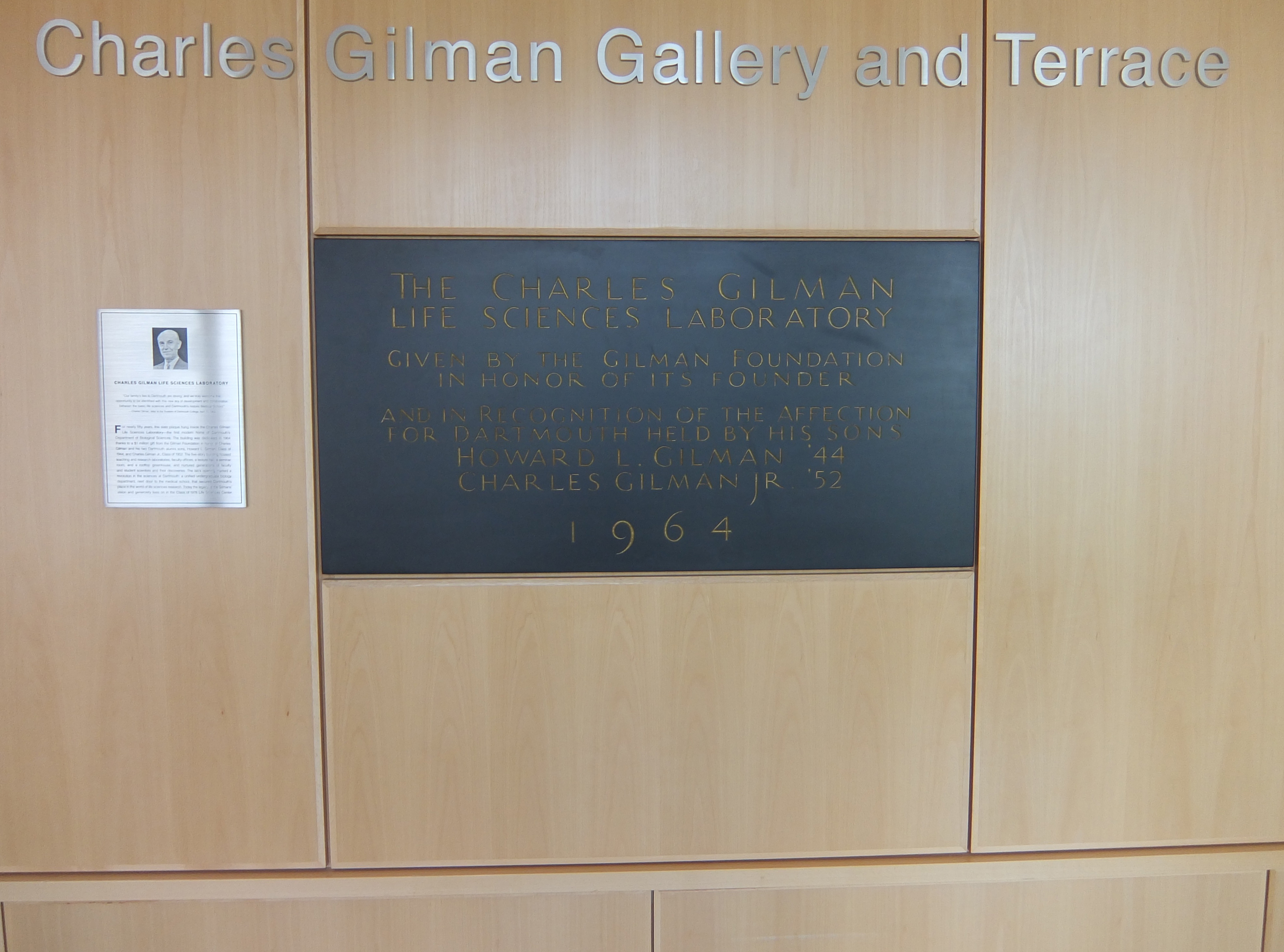
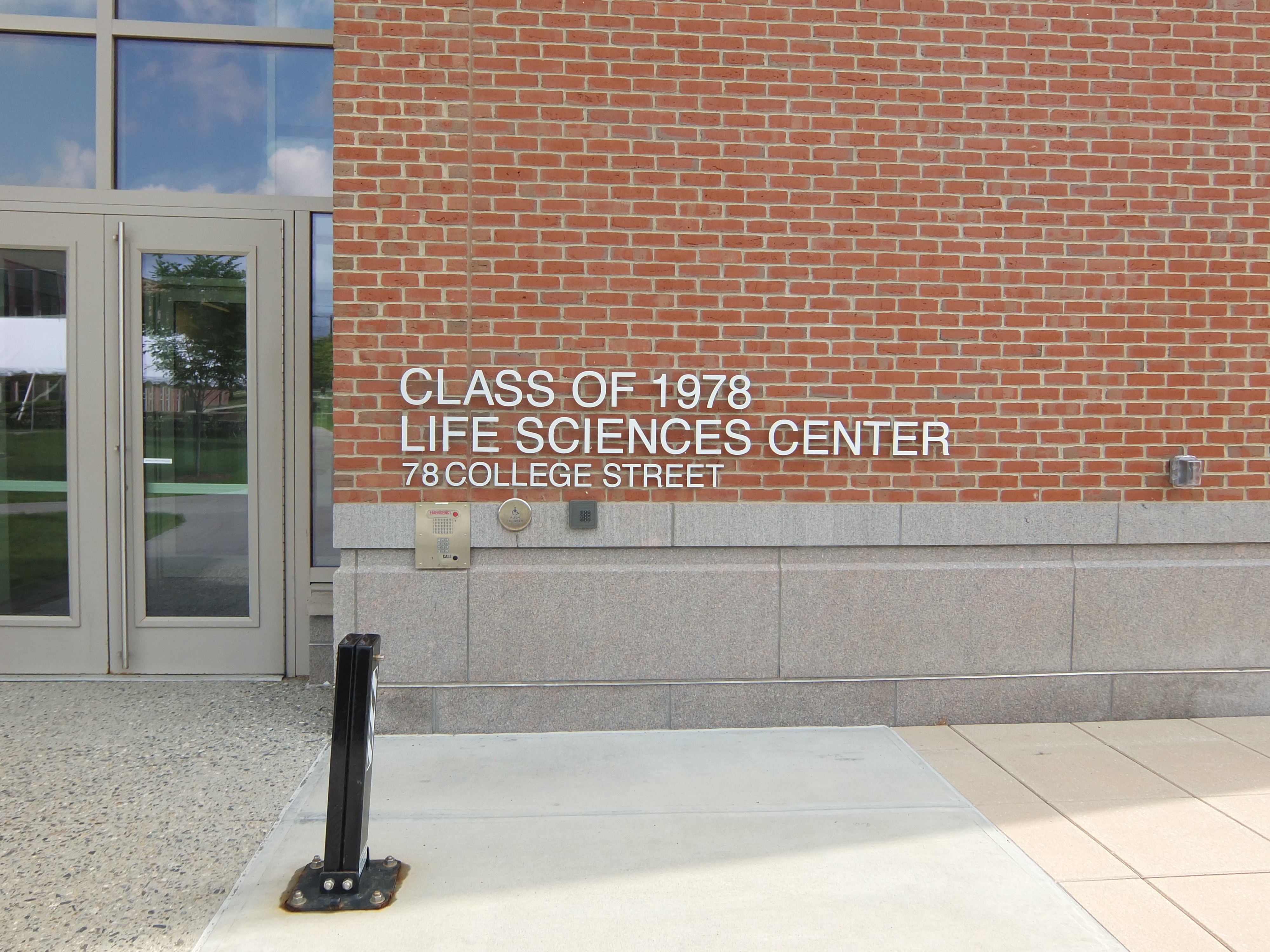
The town changed the street address of the building to get it to match.
Computer Science Department to move to new Thayer School building
Google Street View
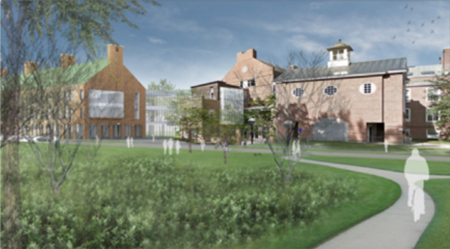
The new building is on the left. Image from Behind the Green newsletter.
The Thayer School of Engineering is planning to expand its faculty, students, and program. They are working closely with our Planning, Design & Construction Office to design a building that will accommodate this growth. The project is being developed in partnership with the Computer Science department and will therefore accommodate the relocation of that department, promoting interaction and collaboration between Thayer and CS, and with Tuck as well. The proposed new building is located south of the Maclean Engineering Sciences Center on the west end of the Dartmouth campus.
That from the Campus Services newsletter.1”A Sampling of Capital Projects Underway,” Behind the Green (2 March 2016) pdf.
The building takes its cues from the successful MacLean ESC next door. It looks as if it will line up directly with the portico of Tuck Hall.
The building also carries on the Thayer tradition of erecting additions rather than freestanding buildings. This is contrary to the two most recent master plans for this area. The road seems to be rerouted at least; will the connection to the River Cluster be eliminated completely?
And who will take over Sudikoff once CS leaves?
The newsletter also has a small rendering of the upcoming Indoor Practice Facility.
——————————
Hood partial demolition controversy in NYT
Hood Museum Renovation Causes a Split, New York Times.
The north end of the museum could be preserved if the school were to expand the project (and the budget) to include the renovation of Wilson Hall as the Hood’s new entrance. That was a feature of Centerbrook’s master plan for the expansion.
Famous for Fine Food: New Lodge images
In the “Giving” part of its website, the college has posted a new page for the replacement Moosilauke Ravine Lodge (thanks Rick). The page includes some new renderings, a site plan (showing Benton and McKenny cabins as slated for replacement), and most notably a video flythrough of the future Lodge.
These illustrations are in addition to the watercolors released earlier.
The building’s somewhat jumbled massing and the layering of its roofs of varied pitches give the impression of accretion over time. There are many traditional elements, including the post-and-beam construction of heavy logs, but the building is unmistakeably Modernist.
Pulling back the basement wall on the downhill side, leaving just the stone piers, reduces the bulk of the building and adds to its elemental, primitive character. One wonders where all the stone will come from; this building will require a lot of stone.
The side-gabled roof of the lower porch, with one of its planes draining back toward the face of the building, seems a bit odd. (This at :51 in the video.) Is this traditional? Is it because this roof must support the big vertical members above? The form of the roof almost implies that this colonnade started as a freestanding covered walkway.
The heavy landscaping for the amphitheater might be a little precious. The outdoor pizza oven sounds like fun, but is not very characteristic of this place. Maybe it will become a part of a new Dartmouth tradition.
Conceiving of the multistory interior chimney as a great stone tower is a good idea. But will it be weird to give this tower so much heft upstairs while it rests on relatively slim pillars downstairs? Will visitors who go “inside” the chimney downstairs feel like they are about to be crushed? The log beams in the ceiling could not possibly hold up the boulders above; will there be any convincing trabeation to create a roof? The bookshelves occupying an Inca ruin downstairs look great; this is more of a library than one would expect.
Hood expansion images published
Last week, writes Dartmouth Now, the board:
approved a capital budget of $83 million to fund a number of projects, including strategic investment in shaping Geisel’s future, and renovations of the Hood Museum of Art and the Moosilauke Ravine Lodge.
The Hood info is finally up at the TWBTA site. Ignore the thumbnail images and view the slideshow, which includes floor plans and larger images. The site plan indicates that the landscape design is by Hargreaves Associates. The expansion video at the Hood’s website give a glimpse of an interesting architectural model.
The lobby image at the firm’s site not only shows the palette of the spare space (a cool vitreous? gray brick on the outer walls, granite or other stone floor, and white plane ceiling) but gives a glimpse into the old museum — the far wall is the partly-covered, partly-revealed exterior of Hood at its dramatic stair.
The firm’s site describes this space:
An atrium above the flexible lobby space connects the museum and Bernstein Center, creating an open, accessible space for the entire Dartmouth community. Active and filled with light, it can be used for installation art, performances, and digital programming while simultaneously providing a place for students to study and learn.
This is the Google Street View of this future lobby space. It is a pity the super po-mo concrete window surrounds can’t be preserved, though.
Two interesting little restoration projects could be part of this expansion. One is the south end of Wilson, where the connection is being severed. Similar infill is depicted in the east side of the Hop where the connections — the iconic gateway and bridge — are being removed. The images give little idea of whether the goal will be to match the existing historic fabric, or do a simple fix, or make the new work stand out from the old.
The Sestercentennial and the College Mace
Introduction
It is common for an academic institution to possess among its “crown jewels” a big ceremonial mace (Wikipedia) that is carried at the head of the Commencement procession and might rest in a special spot during the times when the board of trustees is in session. Dartmouth does not have a mace per se, but the College Usher leads the Commencement procession with Lord Dartmouth’s Cup (visible at the right side of this college Flickr photo), a tall 1848 silver vessel that certainly serves the purpose of a mace.
The mace in the U.S.
The college received the cup until 1969 and did not start using it in processions until 1983. Dartmouth does not seem to have had a mace before that time. Why not? It is not clear. It might be that the academic mace is mostly a recent phenomenon in this country. Here is a list of some notable North American college maces:
-
Yale (1902, by Tiffany & Co., with the presidents’ names engraved on the shaft; various colleges and schools possess their own later maces. The mace of the School of Public Health says “DISEASE PREVENTION”).
-
William & Mary (a 1923 gift to the state-run Normal School for white men, the mace featured a Confederate seal and battle flag).
-
Brown (1928).
-
Columbia (an unrelated 18th-century mace given in 1933).
-
Michigan (1952, incorporating building fragments; a mace of 1968 is now used).
-
Penn (1955).
-
Princeton (pdf) (1956, a gift of the locality).
-
University of Washington (1961).
-
Cornell (1962).
-
Gallaudet (1969, incorporating wood from three historic buildings).
-
UNLV (1970, surprisingly weird and excellent).
-
James Madison University (1979).
-
Thomas Jefferson University (1986, featuring the school’s winged ox).
-
Notre Dame (apparently ca. 1987).
-
U.Va. College at Wise (two maces, one given 1988 by The Poor Farm Society, apparently a sort of Seven Society at Wise).
-
University of Alabama at Birmingham (1989, reminds one of Barad-dûr).
-
University of Wisconsin-Green Bay (2001, with successive chancellors adding their signatures to a document stored in the handle).
-
New Mexico State University (pre-2005, incorporates a part of a building that burned in 1910 and is topped with a metal representation of a cactus flower).
-
Michigan State (2005).
-
UBC Okanagon (2009, taking the shape of a Native paddle).
-
University of Miami (1986, donated 2010).
-
University of Missouri (2014).
-
Bob Jones University (2014, incorporating a walking stick given to a past president).
A future mace
It would not be surprising if some alumnus or organization were to come up with the idea of presenting the college with a mace on the occasion of its 250th anniversary in 2019. (That time is not too far off: the 250th anniversary class is already in college.) The mace would not only commemorate the granting of the charter but also would symbolize the independence of the institution from the state, with 2019 being the bicentennial of the Dartmouth College Case.
At best, this old-style mace would be fashioned by New England craftspeople,1In addition, the Medallic Art Company has available a selection of maces, mostly with wooden staffs, and Thomas Fattorini Ltd. of England (pdf) makes metal maces. but it need not follow the traditional mace form. Why not have it refer to a Cabin & Trail splitting maul; a woodsman’s cant hook or peavey; a Mountaineering Club ice axe; or an Organic Farm timber-framer’s mallet?
Perhaps the mace could encapsulate within it some historic implement, such as a cane or cane-head that belonged to Daniel Webster; a nineteenth-century axe used in the Second College Grant; a Boston Post Cane from a defunct New Hampshire town with some connection to the college; an ice axe used on a Himalayan expedition during the 1960s; a broom handle used by John Kemeny to prop open the cabinet of an overheating computer; or a hatchet that Robert Frost used in his woodlot. What about a nineteenth-century canoe paddle?
Any of these venerable tools would be sheathed in a protective silver capsule before being gilded, covered in worked sheets of precious metals, engraved, and decorated with jewels. The encrusting might include polished fragments of the Old Pine, the granite front step of Dartmouth Hall,2That step is located at the entrance to Dick’s House. or a piece of wood or stone from the original building of Moor’s Charity School in Connecticut. Parts of the weathered head and handle of the enclosed cane or axe might be left uncovered, and other parts, perhaps the sharp ones, might be made visible through small crystal windows.
So that a person would be available to carry this new ceremonial mace, the board might have to create the office of Quartomillenial Beadle or Semiquincentennial Macebearer.3The charter office of College Usher, currently conferred upon the Treasurer, now imposes upon its occupant the task of carrying Lord Dartmouth’s Cup in processions. The charter office of College Steward might be available, although one might expect its occupant to be the head of DDS and to carry, say, a giant silver repoussé ladle engraved with the word “COMMONS.”
[Update 12.06.2015: Three broken links fixed.]
——–
| ↑1 | In addition, the Medallic Art Company has available a selection of maces, mostly with wooden staffs, and Thomas Fattorini Ltd. of England (pdf) makes metal maces. |
|---|---|
| ↑2 | That step is located at the entrance to Dick’s House. |
| ↑3 | The charter office of College Usher, currently conferred upon the Treasurer, now imposes upon its occupant the task of carrying Lord Dartmouth’s Cup in processions. The charter office of College Steward might be available, although one might expect its occupant to be the head of DDS and to carry, say, a giant silver repoussé ladle engraved with the word “COMMONS.” |
Gilman entering decrepitude
Wheelock’s Mansion House sold
The Valley News reports that the college is selling Eleazar Wheelock’s house to the Eleazar Wheelock Society, a “pan-denominational resource promoting a constructive role for faith in learning environments like Dartmouth,” as well as at Dartmouth itself. The group will remodel the building to house 24 students. The college only acquired the house a few years ago, and it seems to be imposing a private historic preservation covenant in this sale. The renovation that turned the house into the Howe Library around 1900 was designed by Charles A. Rich, while the ominous/cute brick stacks addition is later.
The “Mansion House” for the college president was built with funds from London evangelical John Thornton, so its acquisition by this group seems particularly appropriate. The group was founded by alumni in 2008 and aims to establish “a reproducible model that can be duplicated on college and university campuses elsewhere.” It admires Wheelock “because of his commitment to the biblical worldview.”
In thanking Joseph Asch for his kind mention of this site on Dartblog, I am compelled to note Princeton’s preservation of an early president’s house1The house is not that of Princeton’s founding president, if the school had such a person: the College of New Jersey was established in Elizabeth and moved to Newark before it settled in Princeton. that is both older than Dartmouth’s and still in its original location. A 1764 engraving by Dawkins (reproduced in a Princeton news article) shows the Maclean House in front and to the right of Nassau Hall. The two buildings are still standing and appear in this recent Bing aerial.
Putting the president’s house alongside the lawn that lay between the street and the college proper was a standard practice. This image shows Dartmouth’s president’s house in its original location at the righthand end of Dartmouth Row.2Although Wheelock died before Dartmouth Hall was built, he anticipated the construction of a college on the hill and likely had the site in mind when he built his own house.
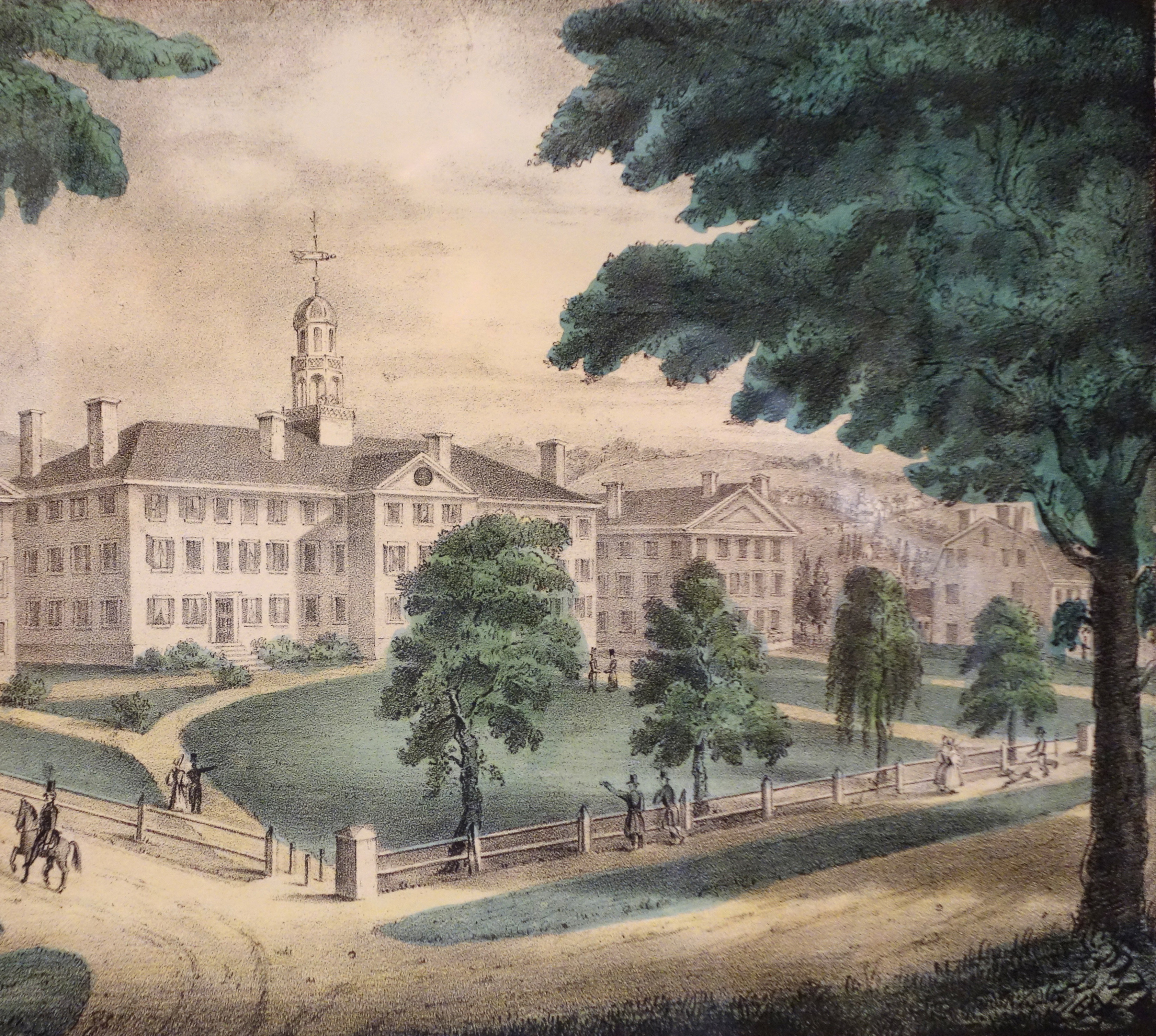
The relation of the president’s house to the college building made early Dartmouth look very much like early Princeton.3 Early views of the two schools are so similar, in fact, that Dartmouth once used the Dawkins engraving of Nassau Hall as the cover of its annual report in error; confirmation will be posted as it is found.
[Update 11.13.2015: Final three paragraphs added.]
——-
| ↑1 | The house is not that of Princeton’s founding president, if the school had such a person: the College of New Jersey was established in Elizabeth and moved to Newark before it settled in Princeton. |
|---|---|
| ↑2 | Although Wheelock died before Dartmouth Hall was built, he anticipated the construction of a college on the hill and likely had the site in mind when he built his own house. |
| ↑3 | Early views of the two schools are so similar, in fact, that Dartmouth once used the Dawkins engraving of Nassau Hall as the cover of its annual report in error; confirmation will be posted as it is found. |
The plaques are back at Memorial Field
The rededication of the memorial plaques that had been returned or relocated to Memorial Field took place last weekend (Alumni Relations press release, Events notice).
The green wall on which the various plaques are mounted faces westward from behind the brick arches of the West Stands. A new circular logo-like relief sculpture by Dimitri Gerakaris ’69 bearing the motto “THE HILL WIND KNOWS THEIR NAME”1The phrase is a reference to a line in the “Alma Mater,” which is a version of the poem “Men of Dartmouth” (“The still North remembers them, / The hill-winds know their name, / And the granite of New Hampshire / Keeps the record of their fame.”). Richard Hovey, “Men of Dartmouth,” in H.J. Hapgood and Craven Laycock, eds., Echoes from Dartmouth (Hanover, N.H., 1895), 12. is an organizing feature; it was donated by the Sphinx Foundation.2The Foundation, of whose board Gerakaris has been a member, maintains the Sphinx Tomb. Its other purposes include being a “reservoir” of college history and preserving the educational ceremonies of the Sphinx (it conducts a “formal annual course on Dartmouth and Sphinx history and tradition” for members). Getting good Internet access through the poured-concrete walls of the tomb must be tough, and indeed one of the group’s accomplishments is the maintenance of “the building’s wireless and high speed conductivity to ensure the Sphinx Building provides the strongest support for undergraduate academic activities.” Those activities include using the library and study stations and engaging in “extensive peer driven learning experiences” (2013 Form 990 PDF). Gerakaris, of Canaan, is the sculptor of the rugby relief on the chimney breast in the Rugby Clubhouse.
The Big Green Alert Blog has a photo of each plaque. The post-1920s plaques were moved here from elsewhere. For pre-1920s plaques, visit Webster Hall, where an Alumni Association plaque lists the 73 Civil War dead and a Class of 1863 plaque lists the 56 class members who served in the Civil War. The two plaques were installed in 1914, about six years after Webster Hall was finished.
Dartmouth does not seem to have a war memorial for any earlier war, and Charles T. Wood’s The Hill Winds Know Their Name (pdf) does not list any. Dartmouth certainly could have a monument to past and future college students and officers who fought in the Revolution; students of Moor’s Charity School are actually more prominent in that war than are Dartmouth students, and at least one (Joseph Brant) took part in both the French & Indian War and the Revolutionary War.
——–
| ↑1 | The phrase is a reference to a line in the “Alma Mater,” which is a version of the poem “Men of Dartmouth” (“The still North remembers them, / The hill-winds know their name, / And the granite of New Hampshire / Keeps the record of their fame.”). Richard Hovey, “Men of Dartmouth,” in H.J. Hapgood and Craven Laycock, eds., Echoes from Dartmouth (Hanover, N.H., 1895), 12. |
|---|---|
| ↑2 | The Foundation, of whose board Gerakaris has been a member, maintains the Sphinx Tomb. Its other purposes include being a “reservoir” of college history and preserving the educational ceremonies of the Sphinx (it conducts a “formal annual course on Dartmouth and Sphinx history and tradition” for members). Getting good Internet access through the poured-concrete walls of the tomb must be tough, and indeed one of the group’s accomplishments is the maintenance of “the building’s wireless and high speed conductivity to ensure the Sphinx Building provides the strongest support for undergraduate academic activities.” Those activities include using the library and study stations and engaging in “extensive peer driven learning experiences” (2013 Form 990 PDF). |
Baker Tower is being remade
The tower of Baker Library will be rehabilitated if not replaced starting next summer (as noted in The Dartmouth and discussed in the Valley News). The design appears to be by Bruner/Cott & Associates of Boston.
The Valley News writes that “with the renovations will come built-in LED illumination that will highlight architectural details ‘in a really elegant way,'” quoting Lisa Hogarty. The lighting design is by Lewis Lighting.
The article describes renovations to the upper, wood-framed portion of the tower, and as usual it leaves out the dirty word “demolition.” But sentences like this one sure make it seem as if the school is planning to demolish at least part of the tower and then replicate it:
Hogarty said the plan was to rebuild the bell tower to “as close to the original architectural details as we can[.]”
Does that mean that just the open cupola with the balcony will be replaced? It is not clear.
The old frame tower and cupola are not finely-worked structures meant for close-up viewing, so the school should be able to replicate precisely those parts that it cannot preserve. One does hope that the school will document before demolition,1The graffiti inside the tower really should be photographed. salvage for another use some of the historic materials that cannot be retained in the new structure, and try to avoid using synthetic materials on the exterior.2The warranty for Hardieplank Artizan HZ10 siding, for example, is limited to thirty years and does not apply in New Hampshire (pdf).
——–
Changes continue at Memorial Field, even after completion
Dartmouth Sports has a press release for the completion of the West Stands, and the Big Green Alert Blog has been publishing photos all along, including on July 1, August 19, and September 24 (completion, and the first interior views).
The Valley News article on the Lone Pine logo contained this intriguing note:
Searching for a concept to provide a sort of mental home-field advantage for his troops, Teevens came up with the idea of “The Woods” a few years back. He once coached at the University of Florida, where the football field is known as “The Swamp” and decided something similar should grace Memorial Field. The nickname is used in promotional materials and videos, and plans are in the works for the phrase and the Lone Pine logo to be painted on the facade of the refurbished west stands.
One hopes that the school’s architectural office, the Office of Design, gives the football team some design assistance here.
It is difficult to tell from photos alone whether the designers had a part in relocating the constellation of plaques that has moved from the War Memorial Garden at the Hop to Memorial Field (see the photo at Big Green Alert).
The stands were built as a First World War memorial, of course, and the memorial heart of the building was the high-vaulted, open entrance chamber of limestone and brick. That memorial room has been demolished; it is understandable that Dartmouth could not afford to preserve the building’s entry, or that the openings were too narrow for the new stairs. The college did salvage the small number of First World War plaques from the walls and has put them up again in circumstances that seem somewhat less reverential than before.
As a generic all-wars memorial, the stands feature a green wall — is it painted concrete, or painted wood? — with some plaques1One does miss the old tradition of putting the date of dedication on a plaque. Attention to wording also seems to be declining: One noble plaque, generously given by surviving classmates, honors the “men who served in WWII and those who gave their lives for their country,” implying that those who gave their lives did not serve, and omitting an indication of the category to which the 24 names belong. attached — including the Class of 1945 Weather Post plaque, apparently separated now from its temperature and pressure dials. This building does seem to be a good place to relocate the plaques if the upcoming Hop expansion requires the use of the garden space. One hopes that the plaques were not moved here for thematic reasons alone.
——–
| ↑1 | One does miss the old tradition of putting the date of dedication on a plaque. Attention to wording also seems to be declining: One noble plaque, generously given by surviving classmates, honors the “men who served in WWII and those who gave their lives for their country,” implying that those who gave their lives did not serve, and omitting an indication of the category to which the 24 names belong. |
|---|
